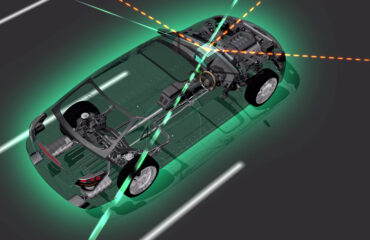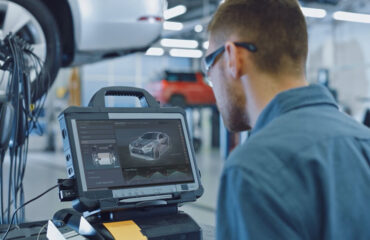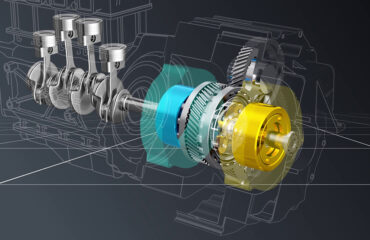


Get ready for some fantastic new training content on Advanced Driver Assist Technology, available now for Autodata Training subscribers. Our Senior Technical Trainer, Ross Hatton, takes us on a tour of what you can expect to find in this all-new course!
Throughout almost the entire history of the automobile, the reality of computer-driven vehicles has eluded even the most forward-thinking and advanced automakers. Yet as we crest the wave of extraordinary technological change into 2020s and beyond, the prospect of true vehicle automation is now – remarkably and rapidly – upon us.
Advanced Driver Assist Systems, or ADAS, represent a genuine pathway to highly automated vehicles, so it’s absolutely vital for every technician to understand the current and future array of different ADAS features, how they work and what they are capable of. That’s why Ross Hatton and the Autodata Training team have just launched the first two of many modules that will make up our ADAS Essentials training course.
In these videos, you’ll start with an introduction to the most common driver assist features, including active cruise control (ACC), autonomous emergency braking (AEB), driver fatigue monitoring, lane keep assist and blind spot monitoring. You’ll then learn how these features are combined together to form more advanced automated systems, such as the semi-autonomous Tesla Autopilot and Mercedes-Benz Drive Pilot systems.
The course also covers more advanced ADAS theory, introducing the underlying operating principles of ‘sense’, ‘understand’ and ‘act’, before explaining the different sensor modalities deployed to support ADAS features, such as ultrasonics, cameras, RADAR & LIDAR. Finally, we explore how ADAS actually interprets and responds to the environment around the vehicle, using the heterogenous processing architecture.
Over the next few months, we’ll be adding additional videos to this course, including deep-dives into each of the sensor types, along with ADAS service and maintenance procedures, and a detailed look at the fascinating world of ADAS and Artificial Intelligence (AI). In the meantime, here’s Ross Hatton on ADAS and understanding the different levels of vehicle autonomy.

Not that long ago, vehicle safety systems were all passive systems – that is, they only worked during or after an accident. Seat belts and air bags are classic examples. Today’s vehicles, on the other hand, now have both passive and active safety systems. The latter work to prevent an accident in the first place, or at least reduce the severity of the impact. Many of these active safety systems form part of the advanced driver assist, or ADAS, suite.
Principally, ADAS relies on a series of sensors placed strategically around the vehicle, which monitor the surrounding environment. Should the system identify a potential hazard and the driver not respond, the vehicle will – depending on its specification – use autonomous braking, steering and/or throttle, to minimize or avoid the impact.
Once only available on high end luxury cars, these systems may now be found on entry level models, albeit in a more basic form. The variety of systems, and systems within systems, can also be quite complex and confusing. For example, many people are not aware that there are different levels of AEB. Ergo, a base model vehicle may lay claim to having AEB, yet it may only be low speed AEB, whilst the top model may add Vulnerable Road User (i.e. pedestrian and cyclist detection) and reverse AEB.
With this in mind, the Society of Automotive Engineers (SAE) have produced a universal classification system that aims to clarify the different levels of driver assistance or automation on any given vehicle.
To make it easier to understand, I will give an overview of the table and provide examples of each level.

First off, you can see that there are two distinct colour zones: blue and green. Most new passenger cars, and many produced within the last five to ten years fall within the blue zone. As per the table, a Level Zero vehicle is limited to providing driver warnings and momentary driver assistance only. This includes Autonomous Emergency Braking (AEB), as well as Cross Traffic Alerts, Traffic Sign Recognition and Blind Spot Monitoring.
Level One introduces a level of automated control to one element of the vehicle only. The best example of this is Active Cruise Control (ACC), which uses radars or cameras to adjust vehicle speed whilst cruise control is engaged, relative to the traffic ahead. In this configuration, the driver is still “driving” the car, and must still steer the vehicle.
Level Two extends the automated control to more than one element, so now steering and braking can be autonomously controlled at the same time. This could take the form of a driver engaging the adaptive cruise control, whilst also using the lane centering assistant to stay between the white lines. Nevertheless, at Level Two, the driver remains “in command” of the vehicle at all times, whilst the ADAS “assists”.
At Level Three, however, we enter the realm of automated driving features. Now, the driver can allow the vehicle to drive itself under specific conditions, but they must remain ready to re-assume control at all times. A Traffic Jam Assistant, which will pilot the vehicle autonomously while queuing on the motorway, for example, would be classified as a Level Three system. Level Three is about the upper limit of current production vehicle technology and legislation – as you’ll see, after this, things get even more advanced and complex.
In moving to Level 4, a vehicle gains the ability to drive itself completely autonomously, without any driver input. However, this must take place under specific and strictly-controlled driving conditions. Autonomous buses are an excellent example – they work on a defined route, often pre-programmed, and in many cases on roads without other, human-driven vehicles. An autonomous mining truck follows a similar principle. In some cases, Level 4 vehicles may also not have a steering wheel or pedals.
Naturally, then, a Level Five vehicle is one that can operate in any conditions, any time, anywhere, without a driver. This seemingly-ambitious proposition is in fact already a technological reality, thanks to the billions of dollars in research and development undertaken by leading technology firms in this space. Yet the challenge of making these vehicles interact safely with other human drivers, and an array of spectacular, as yet unresolved, legislative hurdles, mean Level Five vehicles are not yet ready for mass production and usage.
In the meantime, it’s crucial for every technician to understand where we are along the pathway to full vehicle autonomy, and the key operating principles of the technology that will take us there. Join Autodata Training today and get access to our new and growing library of ADAS training content, and make sure you’re up to speed with the very latest automotive systems and technology.




